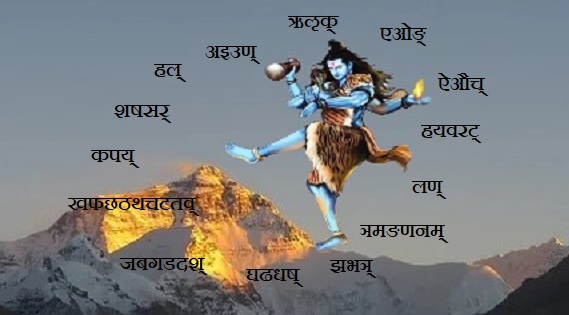Maheshwari Sutrani
माहेश्वरी-सूत्राणि

Chapter
1
Skill Level
All
Language
Sanskrit explained in English
Overview
Till some time back, very few people took interest in understanding and learning languages like Sanskrit. However, nowadays there is renewed interest in learning Sanskrit all around the world.
This interest stems from various topics like Yoga, Ayurveda, Ancient Science, Spiritual Texts and Literature among other things. People have translated many Sanskrit texts into their own languages, which has helped tremendously. However, There are many who want to understand and learn from the source, which brings them to learn Sanskrit.
Sanskrit grammar is very methodical and has pre-defined rules. Once a person understands these rules, it becomes easy to read and understand Sanskrit. We have tried to put content on Sanskrit grammar which is detailed, yet concise, and easy to understand.
The Maheshwari Sutrani is the first chapter in this series. This chapter explains the origins of the Sanskrit Alphabet i.e. the foundation of Sanskrit Grammar as we understand it today.
Learning this chapter will help you:
- Understand the origin of Sanskrit Alphabet
- Know who created the Ashtadhyayi
- Know what is Ashtadhyayi
- Learn the Maheshwari Sutras
Who is the chapter for?
- Any person interested in learning Sanskrit.
- Any learner who wants to revisit the basics of Sanskrit language.
- One who wants to know the origin of Maheshwari Sutras.
माहेश्वरी-सूत्राणि
Māheśvarī-Sūtrāṇi
The Māheśvarī-Sūtrāṇi also commonly known as the Maheshwara Sutras or Shiva Sutras or Maheshwari Sutras are 14 Sutras which contain all the letters of the Sanskrit alphabet.
Lord Shiva, when he performed the cosmic dance called Tandav Nritya for the sages, fourteen Sutras (Maheshwari Sutras) were heard from his Damaru (musical instrument), which came to be known as the Śivasūtrajālam.
Sage Panini by the grace of Lord Maheshwara i.e. – Lord Shiva composed the work on Sanskrit grammar in a book called the Ashtadhyayi. The Ashtadhyayi (Sanskrit: अष्टाध्यायी; Transliteration: aṣṭādhyāyī) is a Sanskrit scripture on grammar consisting of eight chapters, which give it its name, delineating the constitutive rules of Sanskrit Grammar in a comprehensive manner. The Ashtadhyayi is made up of small statements, called Sutrani (Sanskrit: सूत्राणि; Transliteration: sūtrāṇi), each of which describes a rule of Sanskrit in the most concise way possible.
Maheshwara Sutras (Māheśvarī-Sūtrāṇi), also known as the Shiva Sutras, are considered to be the foundation of Sanskrit. The Sanskrit Varnamala, or the Sanskrit Alphabet has been created from the Maheshwari Sutras.
The above content is derived from the following verse:
नृत्तावसाने नटराजराजो ननाद ढक्कां नवपञ्चवारम्।
उद्धर्तुकामः सनकादिसिद्धानेतद् विमर्शे शिवसूत्रजालम्॥
Nṛttāvasāne naṭarājarājo nanāda ḍhakkāṃ navapañcavāram।
Uddhartukāmaḥ sanakādisiddhānetad vimarśe śivasūtrajālam॥
अष्टाध्यायी (aṣṭādhyāyī) is considered to be one of the best works of sage Pāṇini. It is the most authoritative Sanskrit grammar text which has survived till date in its totality, which is – complete and not diluted.
The word Aṣṭādhyāyī means eight chapters, which is a combination of the two words ‘अष्ट’ meaning ‘eight’ and ‘अध्यायः’ meaning chapter. The eight chapters are further divided into four sections each called the padas. These eight chapters have a total of 3,959 sutras.
The below given table contains the Maheshwari Sutras:
स्वराः (svarāḥ)
| Devanagari | IAST |
| अइउण् | aiuṇ |
| ऋऌक् | ṛḶk |
| एओङ् | eoṅ |
| ऐऔच् | aiauc |
व्यञ्जनानि (vyañjanāni)
| Devanagari | IAST |
| हयवरट् | hayavaraṭ |
| लण् | laṇ |
| ञमङणनम् | ñamaṅaṇanam |
| झभञ् | jhabhañ |
| घढधष् | ghaḍhadhaṣ |
| जबगडदश् | jabagaḍadaś |
| खफछठथचटतव् | khaphachaṭhathacaṭatav |
| कपय् | kapay |
| शषसर् | śaṣasar |
| हल् | hal |
Each of these sutras is a Pratyahara itself. A Pratyahara (Sanskrit: प्रत्याहारः ; Transliteration: pratyāhāraḥ) is an abbreviation of sorts, combining the letter at the beginning and at the end to refer to an entire set of letters.
Pratyaharas are widely used in many of the Paninian Sutras. These help to refer to the entire set of letters, without mentioning each component separately.
Vowels and Consonants in Paninian Grammar are also referred to in such a manner:
- Vowels: अच् (Ac): This refers to all the letters ‘अ’, ‘इ’, ‘उ’, ‘ऋ’, ‘ऌ’, ‘ए’, ‘ओ’, ‘ऐ’ and ‘औ’, which are contained within their respective sutras, all encompassed under ‘अच्’.
- Consonants: हल् (Hal): This refers to all the letters ‘ह’, ‘य’, ‘व’, ‘र’, ‘ल’, ‘ञ’, ‘म’, ‘ङ’, ‘ण’, ‘न’, ‘झ’, ‘भ’, ‘घ’, ‘ढ’, ‘ध’, ‘ज’, ‘ब’, ‘ग’, ‘ड’, ‘द’, ‘ख’, ‘फ’, ‘छ’, ‘ठ’, ‘थ’, ‘च’, ‘ट’, ‘त’, ‘क’, ‘प’, ‘य’, ‘श’, ‘ष’, ‘स’ and ‘ह’.
It should be kept in mind here, that the consonants at the end of the sutras are not actually included when we refer to a Pratyahara.